So, here I go...
I've decided to mod my DCX to full extent. I already did the capacitor passive out and digital direct in mods and further I'll replace the power supply, the clock, the ASRC and DAC's in that order. It's a whole lot of work and investment but I love my DCX and going for a Nadja DSP would be more expensive as I estimated. Also I like the sound of the unit very much as-is, especially after getting a WaveIO and a ReflektorD for it, and switching to AP Linux for playing hi-res files.
Let's talk about the power supply. I'll ditch the SMPS and go for Salas shunts. I studied the schematic pretty closely so I know my way around the DSP board. The number of required voltages is pretty high but after some design decisions I decided to leave out the +-15V rails as I don't need the output stage, also ditch the +9V feeding the two on-board 7805s. One of them feeds the A/D converters, which I don't plan to use, and the other the DACs. The +5V for their supply gets further lowered to 3.3V via a transistor and some resistors. I find that unacceptable and plan to separate it.
The voltages I'll need are 5V and 3V feeding the digital part and also for the front panel and another 5V and 3V for the DACs.
The only hiccup in this plan is a TL072 amplifying a signal PWM0 to LCDVEE and this is where I need your help.
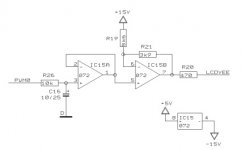
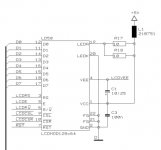
I guess it's for setting the contrast on the front panel LCD, but I'm not sure what voltages does the TL072 output and could I simply replace it with a trimmer and set the contrast manually if that's what it really does. I don't feel like dissecting the DCX just to measure the LCDVEE now when I'm in the design phase knowing the fragility of the DSP board.
Anyway here's the compete schematic and the picture of a half-complete DSP board mod.
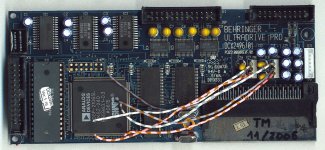
Please point to any flaws in my plan.
I've decided to mod my DCX to full extent. I already did the capacitor passive out and digital direct in mods and further I'll replace the power supply, the clock, the ASRC and DAC's in that order. It's a whole lot of work and investment but I love my DCX and going for a Nadja DSP would be more expensive as I estimated. Also I like the sound of the unit very much as-is, especially after getting a WaveIO and a ReflektorD for it, and switching to AP Linux for playing hi-res files.
Let's talk about the power supply. I'll ditch the SMPS and go for Salas shunts. I studied the schematic pretty closely so I know my way around the DSP board. The number of required voltages is pretty high but after some design decisions I decided to leave out the +-15V rails as I don't need the output stage, also ditch the +9V feeding the two on-board 7805s. One of them feeds the A/D converters, which I don't plan to use, and the other the DACs. The +5V for their supply gets further lowered to 3.3V via a transistor and some resistors. I find that unacceptable and plan to separate it.
The voltages I'll need are 5V and 3V feeding the digital part and also for the front panel and another 5V and 3V for the DACs.
The only hiccup in this plan is a TL072 amplifying a signal PWM0 to LCDVEE and this is where I need your help.


I guess it's for setting the contrast on the front panel LCD, but I'm not sure what voltages does the TL072 output and could I simply replace it with a trimmer and set the contrast manually if that's what it really does. I don't feel like dissecting the DCX just to measure the LCDVEE now when I'm in the design phase knowing the fragility of the DSP board.
Anyway here's the compete schematic and the picture of a half-complete DSP board mod.

Please point to any flaws in my plan.
Attachments
Hi Petter,
I'm afraid there is no "Master volume control"...
Hi this is a lack that i really do not understand.
I mean ... i think that anyone is going to use the unit sending a digital signal in ... how can it be possible to control the volume ???
Can anyone explain me this that i consider a flaw in the design ?
How many boxes are needed to set-up a chain ?
Unbelievable. Sorry and thanks to anyone.
Regards, gino
There is a volume control on the inputs which controls all outputs simultaneously, also on each individual output. But these ar more for a one-time adjustment to compensate for power amp and speaker sensitivity differences. You obviously would control volume from your preamp. This is not a preamp.
CAREFUL when buying new units: they changed the design significantly. No longer a slot on the front panel where you could mount a display as I did in my remote volume control - yes I made it into a preamp.
BTW the TL072 on the display brightness is preceded by a low-pass and you could just measure the DC at it's output.
Jan
CAREFUL when buying new units: they changed the design significantly. No longer a slot on the front panel where you could mount a display as I did in my remote volume control - yes I made it into a preamp.
BTW the TL072 on the display brightness is preceded by a low-pass and you could just measure the DC at it's output.
Jan
Last edited:
There is a volume control on the inputs which controls all outputs simultaneously, also on each individual output. But these ar more for a one-time adjustment to compensate for power amp and speaker sensitivity differences. You obviously would control volume from your preamp.
Hi and thanks a lot for your very kind and valuable reply.
Actually i would love to be able to control the overall volume from this unit indeed (i.e. master volume on the DCX2496).
Also because i am sure this could be done quite easily in the digital domain ... almost quite easily.
If i understand well this is clearly a digital unit.
I should have an analog preamp in front of it and send the signal to an AD and then DA conversion in the DCX ? this is crazy.
i would add ... unfortunately. This for me is a really serious drawback.This is not a preamp.
I have this ULTRADRIVE PRO DCX2496 but i have not used it yet a little intimidated by its complexity ... i am very unexpert.
I hoped for a master volume feature for sure.
Especially seeing that big multifunction knob.
CAREFUL when buying new units: they changed the design significantly, no longer analog inputs, just digital in and 6-way analog out.
i do not understand anymore ... if the inputs are digital how can i control the volume ???
No longer a slot on the front panel where you could mount a display as I did in my remote volume control - yes I made it into a preamp.
Jan
Well first of all my sincere congratulations for your great upgrading.
I understand you had the same necessity ... to control the overall volume with the same unit.
Sometimes i ask myself if between the designing department and the end users there is really a connection.
They should give people what people need, want, desire ...
I am more than sure that a master volume feature in the unit would be very very much appreciated by anyone.
I would like to sell it without using ... seriously.
I even do not understand how i could use it.
Thanks a lot for the valuable advice, gino
Hi ... found something here
Speaking of active crossovers..

so maybe from the SW ? that would be fantastic
A wireless app would be even a nicer touch but ...
Regards, gino
Speaking of active crossovers..

...But I'll beg to disagree on the master volume.
Here's a screenshot of the software I took a long time ago. On the right window, the leftmost slider controlled ALL volume that exits the machine.
It controlled the second and third sliders, which were tied together and were the right and left channels. ...
so maybe from the SW ? that would be fantastic
A wireless app would be even a nicer touch but ...
Regards, gino
You can apply small attenuations in the digital domain and your speaker outputs should not reveal any poor sound.
You can apply big digital domain attenuations, either in the DCX, or before the DCX. But you are likely to hear some loss in sound quality. The higher the attenuation the worse the quality becomes.
If you require more than -10dB of attenuation in any channel you may begin to hear this.
This would accommodate trimming of channels to suit different speaker sensitivities.
But would not suit big changes in listening volume as one would use during varied home use.
You can apply big digital domain attenuations, either in the DCX, or before the DCX. But you are likely to hear some loss in sound quality. The higher the attenuation the worse the quality becomes.
If you require more than -10dB of attenuation in any channel you may begin to hear this.
This would accommodate trimming of channels to suit different speaker sensitivities.
But would not suit big changes in listening volume as one would use during varied home use.
Gino,
If this is a unit you're going to hang onto for awhile, consider modifying it with Jan's modification. The stock DCX2496 has numerous issues/drawbacks for those of us using it in a non-professional environment. Jan's modification fixes every single one of those issues.
Dave.
If this is a unit you're going to hang onto for awhile, consider modifying it with Jan's modification. The stock DCX2496 has numerous issues/drawbacks for those of us using it in a non-professional environment. Jan's modification fixes every single one of those issues.
Dave.
A wireless app would be even a nicer touch but ...
Regards, gino
Unfortunately, it's only controllable from a PC through an RS232 link - or MIDI.
Do read the manual....
Jan
You can apply small attenuations in the digital domain and your speaker outputs should not reveal any poor sound.
You can apply big digital domain attenuations, either in the DCX, or before the DCX. But you are likely to hear some loss in sound quality. The higher the attenuation the worse the quality becomes.
If you require more than -10dB of attenuation in any channel you may begin to hear this. This would accommodate trimming of channels to suit different speaker sensitivities.
But would not suit big changes in listening volume as one would use during varied home use
Hi and thanks a lot indeed.
I see now that acting on the volume digitally ruins the sound.
So in the end this thing is supposed to be used after an analog preamp ?
The idea of another AD-DA passage leaves me quite perplexed.
Thanks again, gino
Gino, If this is a unit you're going to hang onto for awhile, consider modifying it with Jan's modification.
The stock DCX2496 has numerous issues/drawbacks for those of us using it in a non-professional environment.
Jan's modification fixes every single one of those issues.
Dave.
Hi Dave, thanks for the helpful advice.
I bought it 2nd for a nice price but never used intimidated by its complexity.
I will look at the mods. But i see smd parts ...
Thanks again, gino
Unfortunately, it's only controllable from a PC through an RS232 link - or MIDI.
Do read the manual....
Jan
Hi that would be also fine if the volume control would not affect the sound quality. I have understood now that this is bad for sound quality.
So a line preamp in front of it is need. I will read the thread first before decide what to do. I am not an expert at all.
Thanks again, gino
I see now that acting on the volume digitally ruins the sound.
That, as a general statement, is wrong.
Digital volume control is totally OK. Some people worry about loss of low-level resolution, but in a 24-bit system, you have something like 70 dB of range before you are down to the dynamic range of a typical real life recording.
Jan, can you confirm that the TL072 actually controls the display contrast? I just made an educated guess...
As for controlling the volume I came up with an elegant solution. There are numerous relay switched resistor network-style around, either in DIY or as an flea-bay kit.
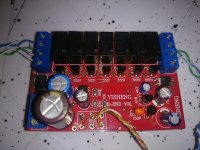
Those use a analog-to digital converter to control the relays via a pot. I desoldered the A/D converter on three of those ebay-boards and connected the relay driving transistors to an arduino microcontroller.
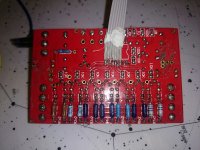
They are very easy to program and have an array of available extensions as a display, rotary encoder od an IR receiver.
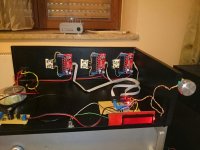
And voila - a six channel volume control for under $200!

As for controlling the volume I came up with an elegant solution. There are numerous relay switched resistor network-style around, either in DIY or as an flea-bay kit.

Those use a analog-to digital converter to control the relays via a pot. I desoldered the A/D converter on three of those ebay-boards and connected the relay driving transistors to an arduino microcontroller.

They are very easy to program and have an array of available extensions as a display, rotary encoder od an IR receiver.

And voila - a six channel volume control for under $200!

That, as a general statement, is wrong. Digital volume control is totally OK. Some people worry about loss of low-level resolution, but in a 24-bit system, you have something like 70 dB of range before you are down to the dynamic range of a typical real life recording.
Hi and thanks a lot and very interesting indeed.
But honestly after all i have not understood how people use this thing.
Do they send in an analog signal or digital just to start.
I would like to understand the best way to use it.
I think that in pro uses they just send in the output of an analog mixer
Maybe a digital mixer could allow for some low-loss digital volume control ?
It is a lot out of my league ... very difficult.
Thanks again, gino
I think that in pro uses they just send in the output of an analog mixer
That is the usual scenario, yes.
It really doesn't matter if the mixer is analog or digital. In any real-life recording situation, you would struggle to achieve more than 75 dB of SNR. 24 bits allows 144 dB, so you have 69 dB of attenuation available before you hit the noise floor...Maybe a digital mixer could allow for some low-loss digital volume control?
Not very difficult - just a bit counter-intuitive at times.It is a lot out of my league ... very difficult.
I strongly recommend https://xiph.org/video/vid2.shtml
That is the usual scenario, yes.
It really doesn't matter if the mixer is analog or digital. In any real-life recording situation, you would struggle to achieve more than 75 dB of SNR.
24 bits allows 144 dB, so you have 69 dB of attenuation available before you hit the noise floor...
So potentially the unit could do volume control in digital domain because it converts the analog inputs in 24 bit digital. It is a pity that this possibility is not used. It is indeed only a digital x-over. Maybe also a eq but not a preamp.
Not very difficult - just a bit counter-intuitive at times.
I strongly recommend https://xiph.org/video/vid2.shtml
I will watch the video before asking other questions.
Still a master volume control would have been a nice thing ... like a cherry on top.
Thanks a lot again, gino
Well gino, I can give you my example of using a DCX.
First, my music is on a computer running AP-Linux and with no volume controll, the volume is set to max permanently. Then the computer is connected to a USB "soundcard" with SPDIF output. The card is Lorien's WaveIO asynchronous USB interface. I feed the SPDIF signal directly to the DCX AES/EBU transformer with a coax cable. After the DCX is a 6-channel volume control I described a few posts earlier. This is where the attenuation of volume happens. From the 6-channel vol ctrl the signal goes to three different amplifiers, for treble, for midbass and for a subwoofer. I use a dipole arrangement for the treble and midbass so some sort of equalization is required and the digital crossover helps a lot too.
-------------
Did anybody measure the power consumption for each power supply rail under load? Tnx
First, my music is on a computer running AP-Linux and with no volume controll, the volume is set to max permanently. Then the computer is connected to a USB "soundcard" with SPDIF output. The card is Lorien's WaveIO asynchronous USB interface. I feed the SPDIF signal directly to the DCX AES/EBU transformer with a coax cable. After the DCX is a 6-channel volume control I described a few posts earlier. This is where the attenuation of volume happens. From the 6-channel vol ctrl the signal goes to three different amplifiers, for treble, for midbass and for a subwoofer. I use a dipole arrangement for the treble and midbass so some sort of equalization is required and the digital crossover helps a lot too.
-------------
Did anybody measure the power consumption for each power supply rail under load? Tnx
Well gino, I can give you my example of using a DCX.
First, my music is on a computer running AP-Linux and with no volume controll, the volume is set to max permanently. Then the computer is connected to a USB "soundcard" with SPDIF output. The card is Lorien's WaveIO asynchronous USB interface. I feed the SPDIF signal directly to the DCX AES/EBU transformer with a coax cable.
After the DCX is a 6-channel volume control I described a few posts earlier. This is where the attenuation of volume happens .
From the 6-channel vol ctrl the signal goes to three different amplifiers, for treble, for midbass and for a subwoofer. I use a dipole arrangement for the treble and midbass so some sort of equalization is required and the digital crossover helps a lot too.
-------------
Did anybody measure the power consumption for each power supply rail under load? Tnx
Hi Marko, thanks for the very helpful reply.
I am quite ignorant so i am here to learn about the unit.
Sorry could you tell me please the post number where you mention your multichannel volume control unit ?
all considered i think i will use it with a balanced line preamp in front of it
I have also an analog x-over always from Behringer. But a professional i respect a lot told me that the digital units are better.
Thanks a lot for the valuable advice.
Kind regards, gino
Last edited:
- Home
- Source & Line
- Digital Line Level
- Behringer DCX2496 digital X-over